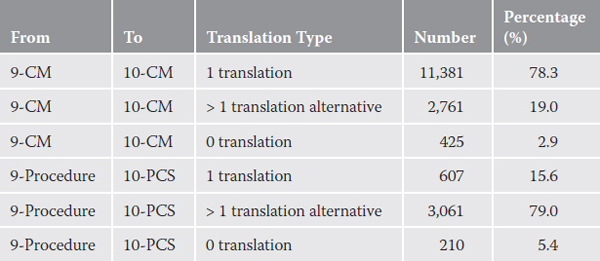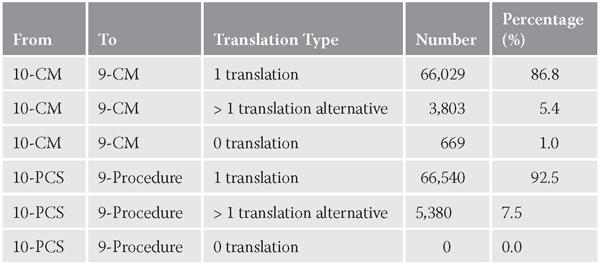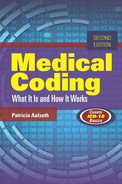General Equivalence Mapping (GEM) Files
The vast differences between ICD-9-CM and ICD-10-CM/PCS pose major challenges for many players in the healthcare arena. Providers and payers have to change their billing and claims processing systems. Researchers, public health administrators, actuaries, and others who rely on historical coded data have to be able to convert data from one system to the other. A need was also identified for a temporary “fix” that could be used in the transition period leading up to October 1, 2015, to run parallel databases and identify potential adverse effects of the change to ICD-10-CM/PCS. To address these issues, over a period of 3 years the Centers for Medicare and Medicaid Services (CMS) and the Centers for Disease Control and Prevention (CDC) developed the General Equivalence Mapping (GEM) files.
The GEMs include “forward mapping” from ICD-9-CM to ICD-10-CM diagnosis codes and from ICD-9-CM procedure codes to ICD-10-PCS procedure codes. They also include “backward mappings” in the other direction. The mappings attempt to find corresponding diagnosis codes between the two code sets, insofar as this is possible. Due to the greatly increased level of detail in ICD-10-CM and ICD-10-PCS, in many cases an exact match is not possible. The mappings include all reasonably equivalent codes and use indicators to note how close the match is.
The degree of matching is also affected by structural changes in ICD-10-CM. An example is the classification method in the chapter on pregnancy, childbirth, and the puerperium. In ICD-9-CM, the classification for most codes is broken down into the current episode of care: delivered, antepartum, postpartum, or unspecified. In ICD-10-CM, the last character in the code represents the trimester of pregnancy: first, second, third, or unspecified. Because the information needed for mapping is not even available, the degree of matching is much lower. A few coding concepts in ICD-10-CM, such as blood alcohol level and underdosing, do not exist in ICD-9-CM, so there is no match for those in the GEMs. Some CM chapters, such as those on neoplasms, infectious diseases, and the eye, contain a higher level of matches because the classification system is more similar between the two code sets.
A single entry in a GEM file is one in which a code in the original system is linked to one or more single codes in the target system. An example from the ICD-9-CM to ICD-10-CM GEM is the following:
ICD-9-CM |
599.72 |
Microscopic hematuria has a valid link to |
ICD-10-CM |
R31.1 |
Benign essential microscopic hematuria, or also a valid link to |
ICD-10-CM |
R31.2 |
Other microscopic hematuria |
Another scenario where matching may be complicated is with combination codes, where a single code represents more than one condition or a condition and an external cause. If there is no combination code in the other code set, or if a combination code in the other code set contains different elements, the mapping will be inexact.
A combination entry in a GEM file is one in which a code in the original system must be linked to more than one code in the target system in order to be a valid mapping. An example from the ICD-10-CM to ICD-9-CM GEM is the following:
ICD-10-CM |
R65.21 |
Severe sepsis with septic shock must link to |
ICD-9-CM |
995.92 |
Severe sepsis and |
ICD-9-CM |
785.52 |
Septic shock |
The following tables show the occurrence of translation alternatives in each GEM file (American Health Information Management Association, 2013).
Forward Mapping

Source: Data from Practice Brief: Putting the ICD-10-CM/PCS GEMs into Practice. May 2013. American Health Information Management Association. Available at http://library.ahima.org/xpedio/groups/public/documents/ahima/bok1_050190.hcsp?dDocName=bok1_050190.
Backward Mapping

Source: Data from Practice Brief: Putting the ICD-10-CM/PCS GEMs into Practice. May 2013. American Health Information Management Association. Available at http://library.ahima.org/xpedio/groups/public/documents/ahima/bok1_050190.hcsp?dDocName=bok1_050190.
The GEMs were developed to serve as an authoritative source for cross-walking between the ICD-9 and ICD-10 code sets. They are intended to serve as tools for large-scale data analysis, transition processes, and research. The GEMs are not intended to be a substitute for learning ICD-10 and are not intended for use in coding individual health records. As demonstrated in the forward and backward mapping tables, many codes have more than one possible translation; using the GEMs to code without agreement on which of the choices is the best within a healthcare entity could lead to chaos and inconsistent data.
In addition to the General Equivalence Mappings, CMS has also developed Reimbursement Mappings. These were derived from the GEMs and were used in converting the DRG algorithms into ICD-10. They differ from the GEMs in that for each ICD-10 code there is only one valid translation. This valid translation may be to a single ICD-9 code or to an ICD-9 “cluster” of two to six codes. The choice of a valid single ICD-9 code was made based on the prevalence of that code in a reference data source of approximately 47 million claims from Medicare and from the state of California. If the only valid mapping for an ICD-10 code is to an ICD-9 “cluster,” then all of the codes in the cluster must be used to ensure the reimbursable components of the ICD-10 code are reproduced in the ICD-9 translation.
Note that CMS does not use the GEMs or the Reimbursement Mappings to process claims. They work directly with the ICD-10 code sets and are converting all of their payment system rules to ICD-10.
The GEMs and the Reimbursement Mappings, with accompanying user’s guides, are in the public domain and are available at:
http://www.cms.gov/Medicare/Coding/ICD10/2014-ICD-10-CM-and-GEMs.html
and
http://www.cms.gov/Medicare/Coding/ICD10/2014-ICD-10-PCS.html.
Reference
American Health Information Management Association. (2013, May). Practice brief: Putting the ICD-10-CM/PCS GEMs into practice. Retrieved January 27, 2014, from http://library.ahima.org/xpedio/groups/public/documents/ahima/bok1_050190.hcsp?dDocName=bok1_050190
